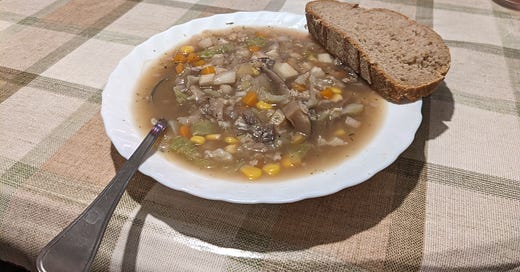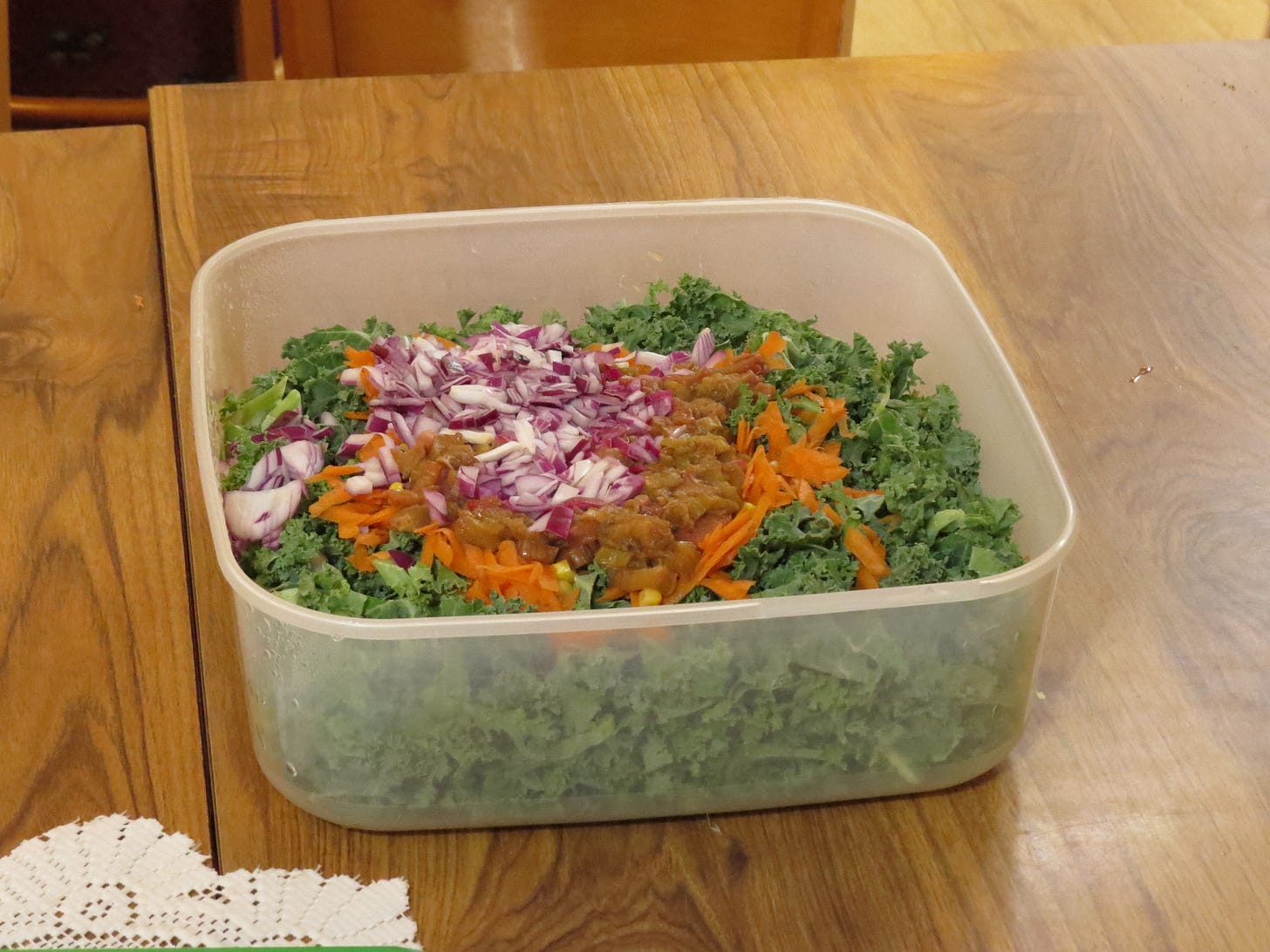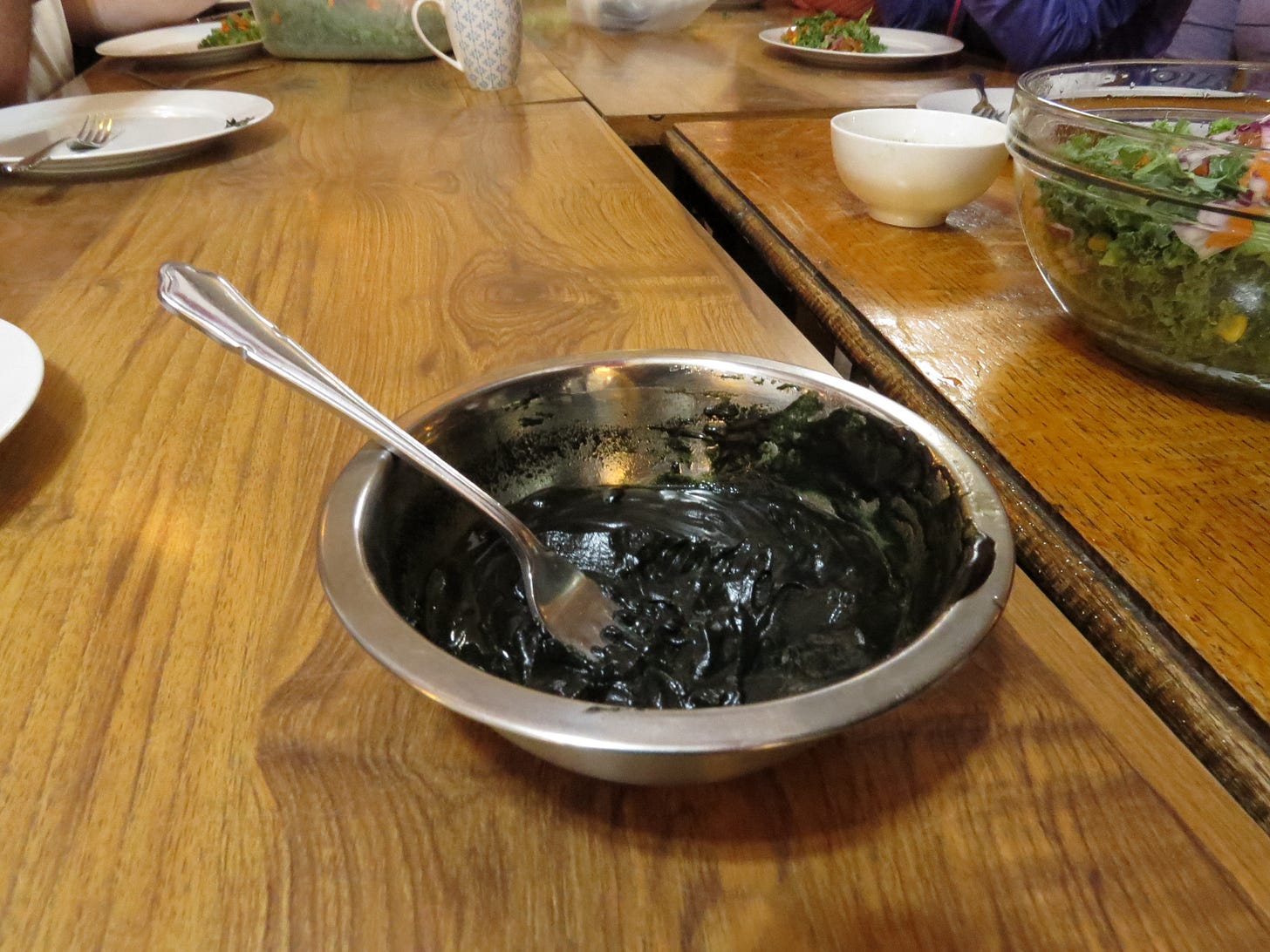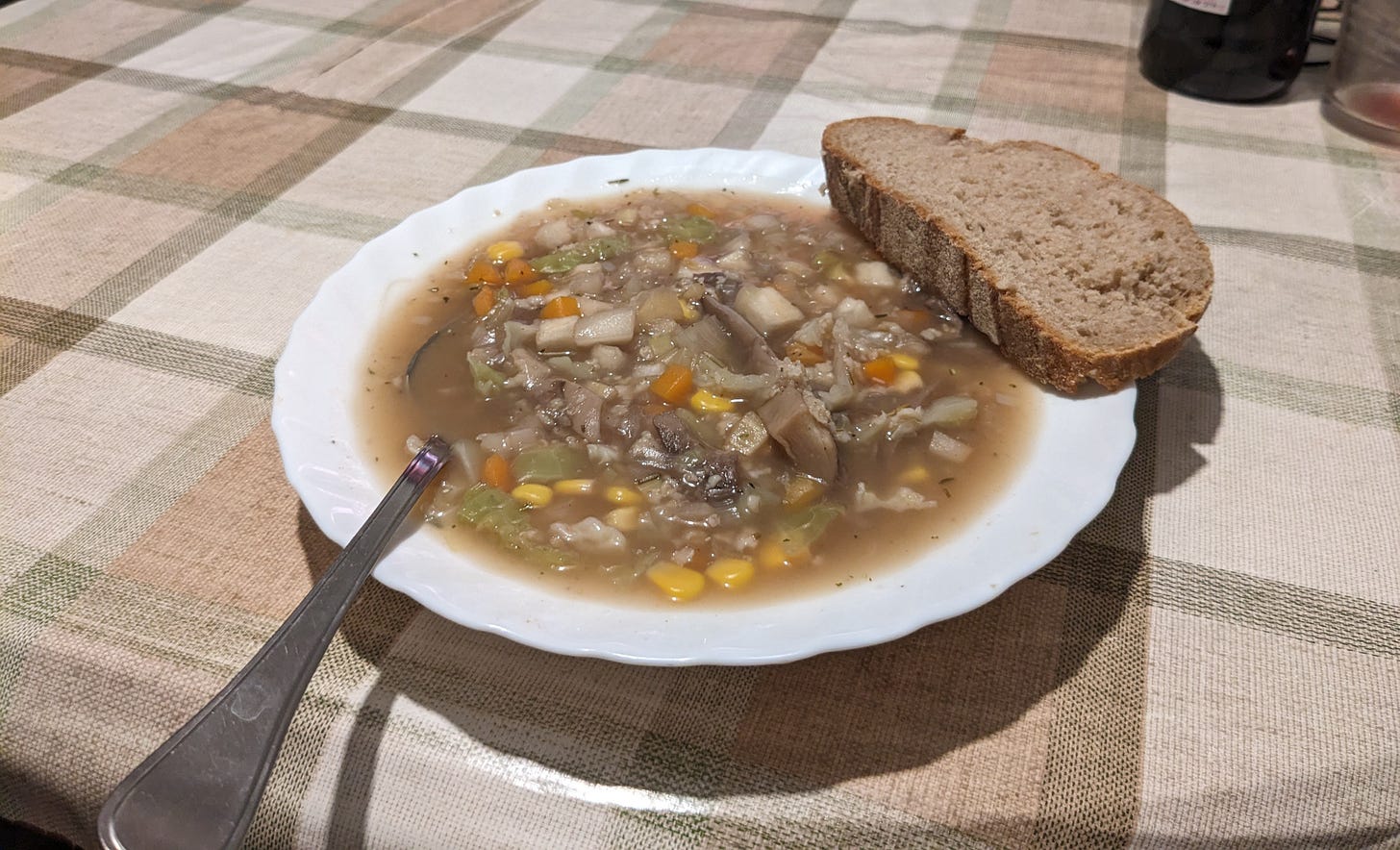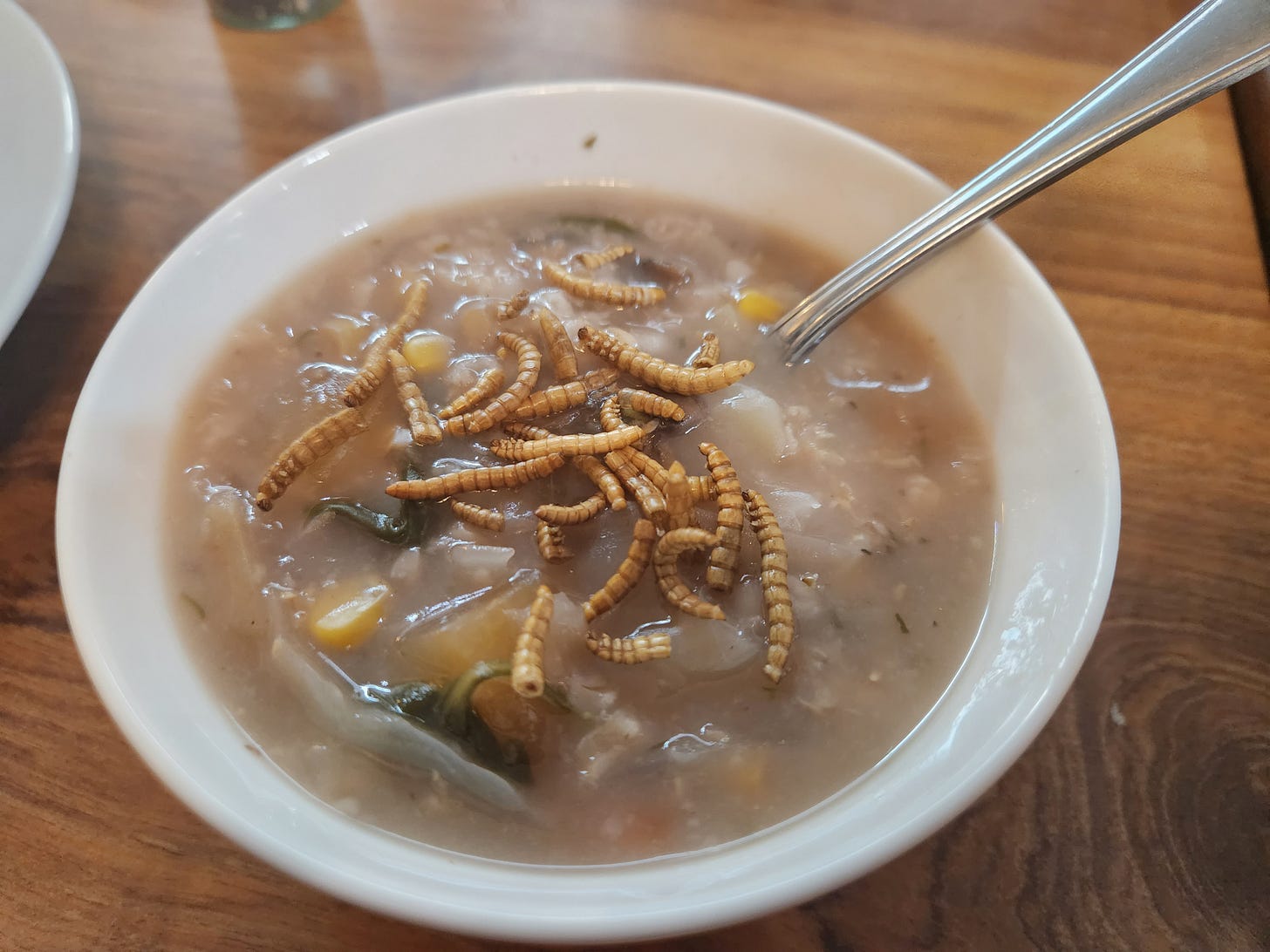Last week we talked about resilient foods. This week, we’re going to look at what a future nuclear winter could look like culinarily if humanity takes sufficient steps to prepare and adapt to the new climactic conditions.
I originally workshopped the idea of a Resilient Foods Dinner with my partner (a researcher at the Alliance to Feed the Earth in Disasters) last fall. It’s a three-course meal1, with each course accompanied by a scientific explanation of why the foods making up that dish might be suitable or reliable in a nuclear winter. Our pilot ran in October 20222 with a group of 25-or-so young professionals in Prague as our guinea pigs, and I was thrilled to be able to present a revised version to the ALLFED team last month at their retreat. That’s the menu I’ll be sharing with you below.
I work heavily off of this chart, which you might remember from last week:

As well as this “shopping list,” which my partner shared with me in advance of our pilot:
While I would love to be able to say I made a delicious dinner out of animal organs, field corn, leaf protein, and glycerine, I am bound by several limitations:
What’s available at the grocery store: ingredients like SCP are somewhat hard to come by, and unreliable. Similarly, multiple people have approached me recommending I press my own Leaf Protein Concentrate to serve at dinner, but no one has ever volunteered to help with this (time-consuming, physically demanding) process. I wonder why.
Dietary restrictions: to make sure my audience can actually eat the food I’m preparing, Resilient Foods Dinner is always at least vegetarian, if not vegan. Two of the recipes below are vegan, and I chose to omit the cheese from the salad to make it vegan as well.
What I expect people to eat: while I imagine my average audience member is somewhat open-minded, my pride will not allow me to serve a dish I don’t know to taste at least acceptable to the human palate, which is why I rely heavily on recipes written by other people. Similarly, I have chosen not to omit seasoning and spices, despite their distinct un-resilience.
Appetizer — Getting Your Five a Day
Surprisingly, something approaching a balanced diet would be possible in a nuclear winter. The current research excludes leafy greens, along with “mushrooms, insects, canola meal, fresh fruits and vegetables, nuts, synthetic fat, [and] leaf protein concentrate,” as it is not guaranteed that these things would be widely available, affordable, or desirable given their low caloric density.
However, they’re extremely desirable to me, which is why we started our dinner with a Rhubarb and Kale Salad.
I’d never cooked with rhubarb before, and I was surprised to learn that after you bake it, it turns into…mush. If you look at the original recipe page, you can see how I was led to believe I’d end up with these cute moon-shaped rhubarb chunks, covered in a sweet balsamic glaze, but that is not what happened. Still, it added something to the homemade vinaigrette we went with, and offset the crunchiness of the very stiff kale.
To adapt this recipe, I replaced the honey in the rhubarb portion with brown sugar (as a scientifically approved stand-in for lignocellulosic sugar, derived from agricultural residue), swapped the shallots for red onion (still not fully resilient, but I forgot to caramelize a regular onion ahead of time — shhh), omitted the fresh lemon, and turned the sunflower seeds into sweetcorn to keep some of the variety in texture they would’ve provided.
Did I say we served it with a homemade vinaigrette? Well, we did, but we also served it with…whatever this was.
I asked my partner to mix up a vinaigrette with a little dash of spirulina, a resilient algae and dietary supplement, inspired by this article by Carla Music. Instead, he kept adding spirulina until this happened. With a consistency the same as that of paint, I can’t say the taste was bad — it definitely added some variety to the salad — but I wouldn’t recommend bringing it to your next dinner party.
Entrée — Feeding the Four Thousand
For our entrée, to make the most of the root vegetables which would survive the best in low-light conditions, we went back to basics: a medieval pottage stew. This is the one recipe we made ahead of time to test out, since no one I knew had ever managed to make pottage taste good, and frankly it’s delicious. I heartily recommend it, in- and outside of nuclear winter, especially with a big chunk of brown bread.
Or, you can do what one brave diner did, and BYOB — bring your own bugs.
Pottage is a medieval staple, perfect for nuclear winter: it’s made up of whatever vegetables you have laying around, in a vegetable broth, with some kind of grain to add volume and variety. While the recipe calls for oats and barley, we had some trouble sourcing barley, so I replaced it with more oats. Adaptation is the name of the game. Otherwise, I replaced the green beans (not resilient) with more sweetcorn (resilient). Even the Europeans admitted the corn went well, even without my American allegiance to it.
I served this with two sides: a simple coleslaw, and my favorite recipe for corn fritters. It is an absolute pain to make fried sides for 30+ guests, but these are just too delicious not to try. They fly off the serving tray every time.
Dessert — Keeping Comfort Food
Unfortunately I didn’t grab any of my own pictures of dessert, since it was playing double-duty as a birthday cake for a team member, but I absolutely recommend this recipe for vegan carrot cake with a “buttercream” frosting. Several people approached me for the recipe afterwards. It was fluffy, sweet, and all around a perfect finish. Other than omitting the walnuts and lemon to match my theme, the only note I have on this recipe is that the buttercream ratio is off — I ended up tripling the cake batter, and only doubled the buttercream frosting, but I could have easily made twice as much cake batter as frosting and ended with a good ratio. The cake is sweet enough on its own without the frosting, but after a couple long days of cooking, I was glad to steal the extra buttercream and enjoy it by itself.

I hope this inspired the chefs among us. If it inspired you, let me know! And as this is the end of our nuclear winter/resilient foods aside, come back next week when we resume our regularly scheduled programming, starting with a look at international policies around nuclear forces and AI integration.
So far; I’m always looking to expand.
On Halloween, appropriately enough.

